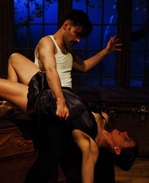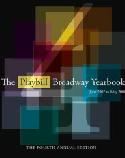SITE GUIDE
SEARCH
REVIEWS
REVIEW ARCHIVES
ADVERTISING AT CURTAINUP
FEATURES
NEWS
Etcetera and
Short Term Listings
LISTINGS
Broadway
Off-Broadway
NYC Restaurants
BOOKS and CDs
OTHER PLACES
Berkshires
London
California
New Jersey
DC
Connecticut
Philadelphia
Elsewhere
QUOTES
TKTS
PLAYWRIGHTS' ALBUMS
LETTERS TO EDITOR
FILM
LINKS
MISCELLANEOUS
Free Updates
Masthead
A CurtainUp Review
Sleep No More
|
Methought, I heard a voice cry, 'Sleep no more!' — Macbeth
|

Nicholas Bruder as Macbeth and Sophie Bortolussi as Lady Macbeth in Sleep No More scene
(Photo: Yaniv Schulman) |
A caveat to potential attendees: This British environmental escapade is for the most adventurous theatergoers, those hearty souls who will go through thick and thin to see their Shakespeare in a fresh new light (or is it a cinematic noir light?). It's not a performance you watch as one within which you live. The evening which can last up to 3 hours transforms attendees into inmates who are expected to shuffle through dark passageways, climb up and down stairs, stroll through cemetery plots, saunter through shrines and studies, zig-zag through mazes — not to mention going in hot pursuit of the dramatic action.
Before undertaking this exploration, there's a stop at the box office to receive a playing card, leave coats, sweaters, and bags in a coatroom. Card in hand, there's another stop at a lounge, replete with a bandstand and bar, where drinks are served and jazz wafts through the air. It's a set-up that encourages f drifting into the mood and atmosphere that will permeate the evening. Soon a tuxedo clad host arrives to welcome the guests to Manderley. He looks and sounds sincere, except that he's likely to evoke Duncan's e words of Duncan from Act 1, Scene 4: "There's no art to find the mind's construction in the face." Despite any reservations this prompts, you'll hand him your card in exchange for a white Venetian-styled mask and it's on to a freight elevator leading to the main part of the performance.
On the elevator there's an urbane young man, with a velvet-smooth voice issuing instructions not to talk during the show and to keep the mask in place at all times. He does reassure his passengers not to worry. that if they feel overwhelmed at any point, there are Actors strategically placed on each floor who can assist anyone feeling overwhelmed. After that, however, he warns that "you will have to find your own way."
Whether you stay the course for two or three hours, Sleep No More will keep you on your feet. No one's experience will be the same, largely because each person gets to pick and choose the rooms to wander through, and the specific actors to watch as they enact various Macbeth episodes. Clearly this is unlike anything else most people will have experienced Not only does it demand a suspension of disbelief, but of conventional notions about theater going. I can only sum it up as art on the run, with Punchdrunk's reimagining of Macbeth fueled by the audience's own adrenaline and boldness.
The better you know Macbeth, the more you will appreciate Sleep No More. Some of the play's major characters you're like to encounter are Macbeth, Lady Macbeth, Macduff, a very pregnant Lady Macduff, Duncan, Banquo, the Porter. Oh, and, of course, the Three Witches. But don't expect to encounter all of them all. If you insist on meeting them all, or want to see a different actor play a particular role (actors sometimes double in parts), count on booking a return visit to the McKittrick.
The rooms in which all these events occur are meticulously designed by Felix Barrett, Livi Vaughan and Beatrice Minns. With my experience obviously differing from yours, it's tough to point you to some most powerful moments, and even tougher not to give away the coup de theater that ends the play like an exclamation mark. But I think it's fair to tell you that watching the bloody rendezvous of Macbeth (in the buff) and Lady Macbeth (in revealing lingerie) in a bathroom following Duncan's regicide is a goose-bump raising spectacle. You won't hear them articulating their famous lines in this mostly wordless show, but you will see them express their psychological angst in stunning dance and mime (choreography by Maxine Doyle) that brings to mind Martha Graham's art.
If you can steel yourself to not return to the lounge or abandon the show rather than stay for the lengthy evening (I was incarcerated for almost 3 hours with the Punchdrunk company), you will certainly get the full impact of this unique theatrical event. Though it's not at all pretentious, Sleep No More will surely pull the rug out of any pretensions you may secretly harbor about the Scottish play. Shakespeare's tragic brainchild dressed in Hitchcock's noir clothing is as exhilarating as it is exhausting, and an utterly mind-altering experience.
Editor's Note: When Lawrence Switzky saw the show in its previous permutation in Boston, he too was enthralled. We've reposted his review below in case you want a second opinion. Review of Sleep No More in Boston
Editor's Postscript: This is one of those shows that seems to have united most critics, but has also divided audiences. For some less than enthusiastic comments see our Letters Page
|
Sleep No More Directed by Felix Barrett and Maxine Doyle. Cast: : Phil Atkins (Duncan), Kelly Bartnik (Catherine Campbell), Sophie Bortolussi (Lady Macbeth), Nicholas Bruder (Macbeth), Ching-I Chang (Sexy Witch), Hope T. Davis (Bald Witch), Stephanie Eaton (Nurse Shaw), Gabriel Forestieri (J. Fulton), Jeffery Lyon (Banquo), Careena Melia (Hecate), Jordan Morley (Boy Witch), Matthew Oaks (Porter), Rob Najarian (Malcolm), Alli Ross (Lady Macduff), Paul Singh (Speakeasy Barman), Tori Sparks (Agnes Naismith) and Lucy York (Matron). Design by Mr. Barrett, Livi Vaughan and Beatrice Minns Choreography by Ms. Doyle Sound by Stephen Dobbie Lighting by Mr. Barrett and Euan Maybank Costumes by David Israel Reynoso Production manager, Bradley Thompson Approximate running time: Depending on what you see, up to 3 hours. Punchdrunk Productions at the McKittrick Hotel 530 West 27th Street From 3/07/11; opening 4/1/11; closing 6/25/11 Extended several times-- currently to 10/08/11 Tickets: $75 Review by Deirdre Donovan on May 11th |
|
REVIEW FEEDBACK Highlight one of the responses below and click "copy" or"CTRL+C"
Paste the highlighted text into the subject line (CTRL+ V): Feel free to add detailed comments in the body of the email. . .also the names and emails of any friends to whom you'd like us to forward a copy of this review. You can also contact us at Curtainup at Facebook or Curtainup at Twitter |
Boston Review of Sleep No More
|
What's done cannot be undone.— Lady Macbeth
|
You enter through a bar called Manderley (Punchdrunk's Hitchcock of choice is Rebecca), which features a live jazz band and serves drinks and foods. You don a white ghost-like mask, and are then whisked into a hotel lobby or an elevator. From there, your experience is up to you. You can follow King Duncan as he is seduced by the witches and then murdered; you can go through the drawers of Lady Macbeth's bedroom; you can dance in a ballroom or at a bacchanal. You can play with Hecate's collection of umbrellas, but she might drag you into her closet for a one-on-one performance if you do.
With the exception of Lady Macbeth's reading of Macbeth's letter reporting his encounter with the three witches, there is only occasional text, spoken softly or shouted feverishly. The actors are also dancers, who match the passions and terrors of Shakespeare's dialogue with sudden leaps across hallways, the delirious thrusts and animal shouts of sex, or gently bathing and undressing a terrified lover.
Punchdrunk works through multi-sensory stimulation, perfuming rooms with lavender, incense, mothballs and pine boughs (including a living simulation of Birnam Woods) and a soundtrack of standards from the '30s and '40s mixed with melodramatic film scores. This balletic rendering of Macbeth probably comes closer than anything else I've ever seen to achieving what Antonin Artaud called "a concrete language of the stage." It's difficult to imagine how its intimate pleasures could be rendered in any other medium.
Since Sleep No More is a story you make up through your sequence of choices, no two experiences are likely to be the same. Despite the veil of secrecy that Punchdrunk smothers around its operation, let me tell you about a couple of don't-miss sequences that I observed. Macduff (Robert McNeill) performs a nightmare dance down hallway, pushing a door, atop which a woman precariously balances before she throws it down on top of him. Lady Macbeth, caught up in the raptures of ambition, unwraps herself from an impossibly long gown and then throws herself around her dressing room, crashing against a pane of glass with sheer animal passion. The funeral procession is accompanied by swarms of patrons in white masks, like a ghost parade. And the mid-performance banquet in the ballroom is played as a slow-motion dance around a table, where the actors whirl back and forth as though you were watching them through Macbeth's maddened eyes. The list could go on and on.
Sleep No More is the most astonishing production to come to Boston in a decade. It's a treat for the adventurous and the patient. Despite the reliance on image, sound and touch over text, it veers between rapid jerks and slow-motion glances, not on short attention spans. If you cannot adjust your own rhythms to match the vertiginous magic, you may find yourself bored or confused. (There are rooms that are simply installations: you are asked to make actions happen in them.) Even if you are up to the challenge, you might find yourself occasionally dazed.
Brave patrons should plan on going on at least two nights. You can never really see the whole thing since scenes occur simultaneously in different locations, but it helps to have one night devoted solely to orientation — besides, this is addictive theater. Like the Second Mrs. de Winter in Rebecca, you'll find yourself returning to its seductions, literally or in your dreams, many times.
|
Sleep No More Directed and Devised by Felix Barrett and Maxine Doyle Staff Director: Mikhael Tara Garver Assistant Director: Paul Stacey Cast (this cast will change before the run ends): Phil Atkins (Duncan), Hector Harkness (Malcolm), Geir Hytten (Macbeth), Vincius Salles (Banquo), Robert McNeill (Macduff), Thomas Kee (Porter), Sarah Dowling (Lady Macbeth), Alli Ross (Lady Macduff), Conor Doyle (Witch), Stephanie Eaton (Witch), Fernanda Prata (Witch), Hecate (Careena Melia), The Second Mrs. de Winter (Poornima Kirby), Mrs. Danvers (Tori Sparks), Bellhop (Alexander LaFrance), Annie Darcy (Annie Goodchild), Elsie Price (Haley Jane Soggin), Man in Bar (Robert Najarian) Opened October 14, 2009 and running through January 3, 2010 Sound and Graphic Designer: Stephen Dobbie Costumer: David Israel Reynoso Stage Manager: Carolyn Rae Boyd Running time: Variable; the play loops once during a three-hour running time Punchdrunk Theatricals hosted by A.R.T. at Old Lincoln School, 194 Boylston Street, Brookline, MA (617) 495-2668 Reviewed by Lawrence Switzky based on the October 22 performance. |
|
Subscribe to our FREE email updates with a note from editor Elyse Sommer about additions to the website -- with main page hot links to the latest features posted at our numerous locations. To subscribe,
E-mail: esommer@curtainup.comesommer@curtainup.com
put SUBSCRIBE CURTAINUP EMAIL UPDATE in the subject line and your full name and email address in the body of the message -- if you can spare a minute, tell us how you came to CurtainUp and from what part of the country. |






